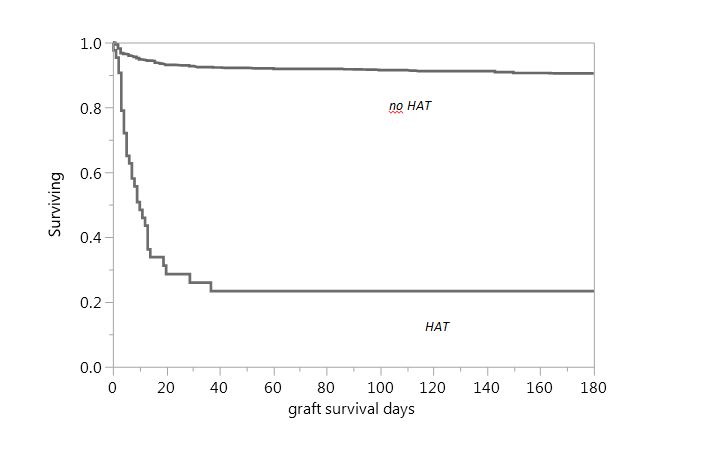Identifying Independent Risk Factors for Graft Loss After Primary Liver Transplantation: A Propensity Score Matched Analysis.
Core Facility Quality Management Transplantation, Hannover Medical School, Hannover, Germany
Meeting: 2017 American Transplant Congress
Abstract number: B199
Keywords: Graft failure, Hepatic artery, Liver transplantation, Risk factors
Session Information
Session Name: Poster Session B: Liver Retransplantation and Other Complications
Session Type: Poster Session
Date: Sunday, April 30, 2017
Session Time: 6:00pm-7:00pm
 Presentation Time: 6:00pm-7:00pm
Presentation Time: 6:00pm-7:00pm
Location: Hall D1
This study aims to identify independent risk factors for graft loss after primary liver transplantation beyond the occurrence of hepatic artery thrombosis. Graft loss was defined as the necessity for re-transplantation or patient´s death due to graft loss. Analyzed were 834 adult patients undergoing primary liver transplantation at Hannover Medical School between 07.06.2002-31.12.2015. It is known that the onset of hepatic artery thrombosis is highly correlated with early graft loss as also shown in the current data.  A propensity score was developed using multivariable binary logistic regression with hepatic artery thrombosis as the dependent variable. The logit link function of the propensity score was included into multivariable Cox regression analyses for graft loss to match the study population.Graft loss was observed in 129 patients (15.5%). Multivariable Cox regression analysis revealed recipient platelet count (p=0.01; HR: 1.002; 95%-CI: 1.000-1.003), a preoperative portal vein thrombosis (p=0.02; HR: 2.029; 95%-CI: 1.140-3.426), donor age (p=0.001; HR: 1.024; 95%-CI: 1.009-1.039), the percentage of macrovesicular steatosis in the donor graft (p=0.03; HR: 1.035; 95%-CI: 1.004-1.063), complications leading to surgical intervention after transplantation (p<0.001; HR: 3.572; 95%-CI: 2.372-5.467), the duration of the transplant procedure in minutes (p=0.002; HR: 1.004; 95%-CI: 1.002-1.007) as well as the transplantation of a split liver graft (p=0.004; HR: 2.613; 95%-CI: 1.364-4.841) to be independent risk factors for graft loss. The logit of the propensity score for the matching of the occurrence of hepatic artery thrombosis did not reach statistical significance in the final multivariable Cox regression model (p=0.25). In conclusion, liver transplant programs might benefit from regular donor organ biopsies. Pairing of an elderly donor with a recipient with a high platelet count or pre-transplant portal vein thrombosis should be avoided. This is especially the case when macrovesicular steatosis is observed or transplantation of a split graft is planned.
A propensity score was developed using multivariable binary logistic regression with hepatic artery thrombosis as the dependent variable. The logit link function of the propensity score was included into multivariable Cox regression analyses for graft loss to match the study population.Graft loss was observed in 129 patients (15.5%). Multivariable Cox regression analysis revealed recipient platelet count (p=0.01; HR: 1.002; 95%-CI: 1.000-1.003), a preoperative portal vein thrombosis (p=0.02; HR: 2.029; 95%-CI: 1.140-3.426), donor age (p=0.001; HR: 1.024; 95%-CI: 1.009-1.039), the percentage of macrovesicular steatosis in the donor graft (p=0.03; HR: 1.035; 95%-CI: 1.004-1.063), complications leading to surgical intervention after transplantation (p<0.001; HR: 3.572; 95%-CI: 2.372-5.467), the duration of the transplant procedure in minutes (p=0.002; HR: 1.004; 95%-CI: 1.002-1.007) as well as the transplantation of a split liver graft (p=0.004; HR: 2.613; 95%-CI: 1.364-4.841) to be independent risk factors for graft loss. The logit of the propensity score for the matching of the occurrence of hepatic artery thrombosis did not reach statistical significance in the final multivariable Cox regression model (p=0.25). In conclusion, liver transplant programs might benefit from regular donor organ biopsies. Pairing of an elderly donor with a recipient with a high platelet count or pre-transplant portal vein thrombosis should be avoided. This is especially the case when macrovesicular steatosis is observed or transplantation of a split graft is planned.
CITATION INFORMATION: Gwiasda J, Schrem H, Kaltenborn A. Identifying Independent Risk Factors for Graft Loss After Primary Liver Transplantation: A Propensity Score Matched Analysis. Am J Transplant. 2017;17 (suppl 3).
To cite this abstract in AMA style:
Gwiasda J, Schrem H, Kaltenborn A. Identifying Independent Risk Factors for Graft Loss After Primary Liver Transplantation: A Propensity Score Matched Analysis. [abstract]. Am J Transplant. 2017; 17 (suppl 3). https://atcmeetingabstracts.com/abstract/identifying-independent-risk-factors-for-graft-loss-after-primary-liver-transplantation-a-propensity-score-matched-analysis/. Accessed December 21, 2025.« Back to 2017 American Transplant Congress
